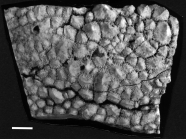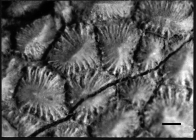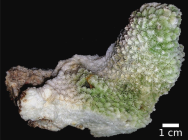WoRMS taxon details
Hydnophora Fischer von Waldheim, 1807
204976 (urn:lsid:marinespecies.org:taxname:204976)
accepted
Genus
Hydnophora demidovii Fischer von Waldheim, 1807 accepted as Hydnophora exesa (Pallas, 1766) (type by original designation)
Hydnophora (Clavarina) Verrill, 1864 · unaccepted > junior subjective synonym
Hydnophoraraea Oppenheim, 1930 † · unaccepted > junior subjective synonym
Hydnophorella Delage & Hérouard, 1901 · unaccepted > junior subjective synonym
Monticularia Lamarck, 1816 · unaccepted > junior subjective synonym
Monticulina Saville-Kent, 1893 · unaccepted > junior subjective synonym
Staminocoenia Gregory, 1930 † · unaccepted > junior subjective synonym
- Species Hydnophora ackermanni Zlatarski, 1972 †
- Species Hydnophora aconus (Oppenheim, 1930) †
- Species Hydnophora astraeoides Martin, 1880 †
- Species Hydnophora blancoensis Wells, 1932 †
- Species Hydnophora bonsai Veron, 1990
- Species Hydnophora bourguetii (Lamarck, 1816) †
- Species Hydnophora crassa Martin, 1880 †
- Species Hydnophora cuvieri Fischer de Waldheim, 1810 †
- Species Hydnophora danai Duncan, 1864 †
- Species Hydnophora demodovii Fischer von Waldheim, 1807
- Species Hydnophora elongata (Duncan, 1880) †
- Species Hydnophora esperi Fischer von Waldheim, 1837 †
- Species Hydnophora exesa (Pallas, 1766)
- Species Hydnophora ferryi de Fromentel, 1877 †
- Species Hydnophora freieslebenii Fischer de Waldheim, 1837 †
- Species Hydnophora grandiconus (Oppenheim, 1930) †
- Species Hydnophora grandis Gardiner, 1904
- Species Hydnophora gregoryi Bosellini, 1999 †
- Species Hydnophora guettardi (Michelotti, 1838) †
- Species Hydnophora hemisphaerica Duncan, 1864 †
- Species Hydnophora henningii Fischer de Waldheim, 1837 †
- Species Hydnophora hubbardi Coryell, 1929 †
- Species Hydnophora humboldtii Fischer de Waldheim, 1837 †
- Species Hydnophora hydnophyllioides (Oppenheim, 1930) †
- Species Hydnophora incerta Morycowa, 1971 †
- Species Hydnophora knorri Fischer de Waldheim, 1810 †
- Species Hydnophora kossmati Felix, 1903 †
- Species Hydnophora latefundata Gregory, 1895 †
- Species Hydnophora longiconus (Oppenheim, 1930) †
- Species Hydnophora maliriensis Duncan, 1880 †
- Species Hydnophora microconos (Lamarck, 1816)
- Species Hydnophora molli Fischer de Waldheim, 1810 †
- Species Hydnophora multilamellosa Reuss, 1854 †
- Species Hydnophora oppenheimi de Angelis d'Ossat, 1905 †
- Species Hydnophora parviconus (Oppenheim, 1930) †
- Species Hydnophora pilosa Veron, 1985
- Species Hydnophora plana Duncan, 1864 †
- Species Hydnophora polygonalis (Blainville, 1834) †
- Species Hydnophora rapula (Oppenheim, 1930) †
- Species Hydnophora rigida (Dana, 1846)
- Species Hydnophora rudis Duncan, 1864 †
- Species Hydnophora sternbergii Fischer de Waldheim, 1837 †
- Species Hydnophora styriana (Michelin, 1847) †
- Species Hydnophora styriana (Oppenheim, 1930) †
- Species Hydnophora venusta (Catullo, 1857) †
- Subgenus Hydnophora (Clavarina) Verrill, 1864 accepted as Hydnophora Fischer von Waldheim, 1807 (unaccepted > junior subjective synonym)
- Species Hydnophora (Clavarina) rigida (Dana, 1864) accepted as Hydnophora rigida (Dana, 1846) (unaccepted > superseded combination)
- Species Hydnophora aurorae Nemenzo, 1988 accepted as Hydnophora exesa (Pallas, 1766) (unaccepted > junior subjective synonym)
- Species Hydnophora aurrorae Nemenzo, 1988 accepted as Hydnophora exesa (Pallas, 1766) (unaccepted > junior subjective synonym, misspelling)
- Species Hydnophora breviconus Nemenzo, 1971 accepted as Hydnophora rigida (Dana, 1846) (unaccepted > junior subjective synonym)
- Species Hydnophora bronni Haime, 1851 † accepted as Pavona bronni (Haime, 1851) † (unaccepted > superseded combination)
- Species Hydnophora columellata Rehberg, 1892 accepted as Hydnophora rigida (Dana, 1846) (unaccepted > junior subjective synonym)
- Species Hydnophora contignatio (Forskål, 1775) accepted as Hydnophora exesa (Pallas, 1766) (unaccepted > junior subjective synonym)
- Species Hydnophora crispata de Angelis d'Ossat, 1894 † accepted as Hydnophyllia crispata (de Angelis d'Ossat, 1894) † (unaccepted > superseded combination, basionym)
- Species Hydnophora danae Duncan, 1864 † accepted as Hydnophora danai Duncan, 1864 † (unaccepted > incorrect grammatical agreement of specific epithet)
- Species Hydnophora demidoffi Fischer von Waldheim, 1807 † accepted as Hydnophora demodovii Fischer von Waldheim, 1807 (unaccepted > misspelling - incorrect subsequent spelling)
- Species Hydnophora demidovii Fischer von Waldheim, 1807 accepted as Hydnophora exesa (Pallas, 1766) (unaccepted > junior subjective synonym)
- Species Hydnophora ehrenbergi Milne Edwards & Haime, 1849 accepted as Hydnophora exesa (Pallas, 1766) (unaccepted > junior subjective synonym)
- Species Hydnophora ehrenbergii Milne Edwards & Haime, 1849 accepted as Hydnophora exesa (Pallas, 1766) (unaccepted > superseded combination, misspelling)
- Species Hydnophora eyessa (Pallas, 1766) accepted as Hydnophora exesa (Pallas, 1766) (unaccepted > misspelling - incorrect subsequent spelling)
- Species Hydnophora gyrosa Milne Edwards & Haime, 1849 accepted as Hydnophora exesa (Pallas, 1766) (unaccepted > junior subjective synonym)
- Species Hydnophora klunzingeri Rehberg, 1892 accepted as Hydnophora microconos (Lamarck, 1816) (unaccepted > junior subjective synonym)
- Species Hydnophora laxa (Dana, 1846) accepted as Hydnophora rigida (Dana, 1846) (unaccepted > junior subjective synonym)
- Species Hydnophora lobata (Lamarck, 1816) accepted as Hydnophora exesa (Pallas, 1766) (unaccepted > junior subjective synonym)
- Species Hydnophora longicolis Reuss, 1864 † accepted as Hydnophyllia longicolis (Reuss, 1864) † (unaccepted > superseded combination, basionym)
- Species Hydnophora maldivensis Gardiner, 1904 accepted as Hydnophora exesa (Pallas, 1766) (unaccepted > junior subjective synonym)
- Species Hydnophora mayori Hoffmeister, 1925 accepted as Hydnophora rigida (Dana, 1846) (unaccepted > junior subjective synonym)
- Species Hydnophora meandrinoides (Micheln, 1842) † accepted as Mycedium meandrinoides (Michelin, 1842) † (unaccepted > superseded combination)
- Species Hydnophora microcona Lamarck, 1816 accepted as Hydnophora microconos (Lamarck, 1816) (unaccepted > misspelling - incorrect subsequent spelling)
- Species Hydnophora microconus (Lamarck, 1816) accepted as Hydnophora microconos (Lamarck, 1816) (unaccepted > misspelling - incorrect subsequent spelling)
- Species Hydnophora palassii Fischer von Waldheim, 1807 accepted as Hydnophora exesa (Pallas, 1766) (unaccepted > junior subjective synonym)
- Species Hydnophora picteti Koby, 1898 † accepted as Eohydnophora picteti (Koby, 1898) † (unaccepted > superseded combination, basionym)
- Species Hydnophora polygonata (Lamarck, 1816) accepted as Hydnophora exesa (Pallas, 1766) (unaccepted > junior subjective synonym)
- Species Hydnophora ramosa Nemenzo, 1959 accepted as Hydnophora rigida (Dana, 1846) (unaccepted > junior subjective synonym)
- Species Hydnophora styriaca (Michelin, 1847) † accepted as Hydnophora styriana (Michelin, 1847) † (unaccepted > superseded combination, basionym)
- Species Hydnophora tenella Quelch, 1886 accepted as Hydnophora exesa (Pallas, 1766) (unaccepted > junior subjective synonym)
- Species Hydnophora ataciana d'Orbigny, 1850 † (uncertain > taxon inquirendum)
- Species Hydnophora conicolobata Milne Edwards & Haime, 1849 (uncertain > taxon inquirendum)
- Species Hydnophora pulchra Michelotti, 1871 † (uncertain > taxon inquirendum)
- Species Hydnophora scripta de Angelis d'Ossat, 1894 † (uncertain > taxon inquirendum)
marine, fresh, terrestrial
recent + fossil
Fischer von Waldheim, G. (1807). <i>Museum Demidoff, ou, Catalogue systématique et raisonné des curiosités de la nature et de l'art: données à l'Université Impériale de Moscou par son excellence Monsieur Paul de Demidoff. Tome III. Végétaux et Animaux</i>. Moscow: Imprimerie de Université Impériale de Moscou. 300 pp, 6 pls. , available online at https://www.biodiversitylibrary.org/page/58562487 [details] 
Description 'Polypier pierreux, crustacé, en masse glomérulée ou en expansions lobées, subfoliacées, ayant sa surface supérieure...
Description Colonies are massive, encrusting or arborescent. The genus is characterised by the presence of hydnophores formed where...
Description 'Polypier pierreux, crustacé, en masse glomérulée ou en expansions lobées, subfoliacées, ayant sa surface supérieure parsemée d'étoiles lamelleuses, à centre solide, pyramidal, et plus ou moins élevé.' (Fischer von Waldheim, 1807: 295) [details]
Description Colonies are massive, encrusting or arborescent. The genus is characterised by the presence of hydnophores formed where...
Description Colonies are massive, encrusting or arborescent. The genus is characterised by the presence of hydnophores formed where sections of common wall between corallites intersect and develop into conical mounds. Hydnophores cover the colony surface and make this genus immediately recognisable. Polyps are usually extended only at night (except H. exesa and H. pilosa). Short tentacles surround the base of each hydnophore, one tentacle between each pair of septa (Veron, 1986 <57>). [details]
Hoeksema, B. W.; Cairns, S. (2024). World List of Scleractinia. Hydnophora Fischer von Waldheim, 1807. Accessed through: World Register of Marine Species at: https://www.marinespecies.org/aphia.php?p=taxdetails&id=204976 on 2024-09-19
Date
action
by
2006-09-13 06:47:38Z
changed
Martinez, Olga
![]() The webpage text is licensed under a Creative Commons Attribution 4.0 License
The webpage text is licensed under a Creative Commons Attribution 4.0 License
original description
Fischer von Waldheim, G. (1807). <i>Museum Demidoff, ou, Catalogue systématique et raisonné des curiosités de la nature et de l'art: données à l'Université Impériale de Moscou par son excellence Monsieur Paul de Demidoff. Tome III. Végétaux et Animaux</i>. Moscow: Imprimerie de Université Impériale de Moscou. 300 pp, 6 pls. , available online at https://www.biodiversitylibrary.org/page/58562487 [details] 
original description (of Hydnophorella Delage & Hérouard, 1901) Delage, Y.; Hérouard, E. (1901). Traité de zoologie concrète. Tome II – Deuxième partie. Les coelentérés. <em>Paris: Schleicher Frères.</em> 848 pp., available online at https://www.biodiversitylibrary.org/page/52123450 [details]
original description (of Monticularia Lamarck, 1816) Lamarck, J.-B. M. de. (1816). Histoire naturelle des animaux sans vertèbres. Tome second. <em>Paris. Verdière.</em> Vol. 2 pp. 1-568., available online at http://www.biodiversitylibrary.org/item/47698 [details]
original description (of Monticulina Saville-Kent, 1893) Saville-Kent W (1893) The Great Barrier Reef of Australia; its products and potentialities, pp. 1-387, pls. 1-48, chromo pls. 1-16. Allen & Co., London., available online at https://www.biodiversitylibrary.org/page/10697730 [details]
original description (of Hydnophoraraea Oppenheim, 1930 †) Oppenheim P. (1930). Die Anthozoen der Gosauschichten in der Ostalpen. <em>Oppenheim, Berlin-Lichterfelde.</em> i-xviii, 1-576. [details]
basis of record Veron JEN. (1986). Corals of Australia and the Indo-Pacific. <em>Angus & Robertson Publishers.</em> [details]
additional source Daly, M.M., Fautin D.G., Cappola V.A., 2003. Systematics of the Hexacorallia (Cnidaria: Anthozoa). Zoological Journal of the Linnean Society 139 3: 419-437.
page(s): 424-425, 427-428 [details] Available for editors [request]
[request]
additional source Randall RH. (2003). An annotated checklist of hydrozoan and scleractinian corals collected from Guam and other Mariana Islands. <em>Micronesica.</em> 35-36: 121-137.
page(s): 134 [details]
additional source Veron JEN. (2000). Corals of the World. Vol. 1–3. <em>Australian Institute of Marine Science and CRR, Queensland, Australia.</em> [details]
additional source Budd AF, Fukami H, Smith ND, Knowlton N. (2012). Taxonomic classification of the reef coral family Mussidae (Cnidaria: Anthozoa: Scleractinia). <em>Zoological Journal of the Linnean Society.</em> 166 (3): 465-529., available online at https://doi.org/10.1111/j.1096-3642.2012.00855.x [details]
additional source Matthai G. (1928). A Monograph of the Recent meandroid Astraeidae. <em>Catalogue of the Madreporarian Corals in the British Museum (Natural History).</em> 7: 1-288, pls. 1-72. [details] Available for editors [request]
[request]
additional source Best MB, Suharsono. (1991). New observations on scleractinian corals from Indonesia: 3. Species belonging to the Merulinidae with new records of Merulina and Boninastrea. <em>Zoologische Mededelingen, Leiden.</em> 65: 333-342. [details]
additional source Duncan PM (1884) A revision of the families and genera of the sclerodermic Zoantharia, Ed. & H., or Madreporaria (M. Rugosa excepted). Journal of the Linnean Society of London, 18: 1-204. [details]
additional source Khalil HM, Fathy MS, Al Sawy SM. (2021). Quaternary corals (Scleractinia: Merulinidae) from the Egyptian and Saudi Arabian Red Sea Coast. <em>Geological Journal.</em> , available online at https://onlinelibrary.wiley.com/doi/10.1002/gj.4145?af=R [details]
additional source Ono, S.; Reimer, J. D.; Tsukahara, J. (2007). Thriving cnidarian community on the volcanic coastline of Sakurajima Taisho Lava Field, southern Japan. Coral Reefs, 26, 95
page(s): 95 [details]
additional source Neave, Sheffield Airey. (1939-1996). Nomenclator Zoologicus vol. 1-10 Online. <em>[Online Nomenclator Zoologicus at Checklistbank. Ubio link has gone].</em> , available online at https://www.checklistbank.org/dataset/126539/about [details]
original description (of Hydnophorella Delage & Hérouard, 1901) Delage, Y.; Hérouard, E. (1901). Traité de zoologie concrète. Tome II – Deuxième partie. Les coelentérés. <em>Paris: Schleicher Frères.</em> 848 pp., available online at https://www.biodiversitylibrary.org/page/52123450 [details]
original description (of Monticularia Lamarck, 1816) Lamarck, J.-B. M. de. (1816). Histoire naturelle des animaux sans vertèbres. Tome second. <em>Paris. Verdière.</em> Vol. 2 pp. 1-568., available online at http://www.biodiversitylibrary.org/item/47698 [details]
original description (of Monticulina Saville-Kent, 1893) Saville-Kent W (1893) The Great Barrier Reef of Australia; its products and potentialities, pp. 1-387, pls. 1-48, chromo pls. 1-16. Allen & Co., London., available online at https://www.biodiversitylibrary.org/page/10697730 [details]
original description (of Hydnophoraraea Oppenheim, 1930 †) Oppenheim P. (1930). Die Anthozoen der Gosauschichten in der Ostalpen. <em>Oppenheim, Berlin-Lichterfelde.</em> i-xviii, 1-576. [details]
basis of record Veron JEN. (1986). Corals of Australia and the Indo-Pacific. <em>Angus & Robertson Publishers.</em> [details]
additional source Daly, M.M., Fautin D.G., Cappola V.A., 2003. Systematics of the Hexacorallia (Cnidaria: Anthozoa). Zoological Journal of the Linnean Society 139 3: 419-437.
page(s): 424-425, 427-428 [details] Available for editors
additional source Randall RH. (2003). An annotated checklist of hydrozoan and scleractinian corals collected from Guam and other Mariana Islands. <em>Micronesica.</em> 35-36: 121-137.
page(s): 134 [details]
additional source Veron JEN. (2000). Corals of the World. Vol. 1–3. <em>Australian Institute of Marine Science and CRR, Queensland, Australia.</em> [details]
additional source Budd AF, Fukami H, Smith ND, Knowlton N. (2012). Taxonomic classification of the reef coral family Mussidae (Cnidaria: Anthozoa: Scleractinia). <em>Zoological Journal of the Linnean Society.</em> 166 (3): 465-529., available online at https://doi.org/10.1111/j.1096-3642.2012.00855.x [details]
additional source Matthai G. (1928). A Monograph of the Recent meandroid Astraeidae. <em>Catalogue of the Madreporarian Corals in the British Museum (Natural History).</em> 7: 1-288, pls. 1-72. [details] Available for editors
additional source Best MB, Suharsono. (1991). New observations on scleractinian corals from Indonesia: 3. Species belonging to the Merulinidae with new records of Merulina and Boninastrea. <em>Zoologische Mededelingen, Leiden.</em> 65: 333-342. [details]
additional source Duncan PM (1884) A revision of the families and genera of the sclerodermic Zoantharia, Ed. & H., or Madreporaria (M. Rugosa excepted). Journal of the Linnean Society of London, 18: 1-204. [details]
additional source Khalil HM, Fathy MS, Al Sawy SM. (2021). Quaternary corals (Scleractinia: Merulinidae) from the Egyptian and Saudi Arabian Red Sea Coast. <em>Geological Journal.</em> , available online at https://onlinelibrary.wiley.com/doi/10.1002/gj.4145?af=R [details]
additional source Ono, S.; Reimer, J. D.; Tsukahara, J. (2007). Thriving cnidarian community on the volcanic coastline of Sakurajima Taisho Lava Field, southern Japan. Coral Reefs, 26, 95
page(s): 95 [details]
additional source Neave, Sheffield Airey. (1939-1996). Nomenclator Zoologicus vol. 1-10 Online. <em>[Online Nomenclator Zoologicus at Checklistbank. Ubio link has gone].</em> , available online at https://www.checklistbank.org/dataset/126539/about [details]
 Present
Present  Inaccurate
Inaccurate  Introduced: alien
Introduced: alien  Containing type locality
Containing type locality
From editor or global species database
Comparison On the morphology tree, Hydnophora is well supported and is sister to the clade formed by Australogyra, Leptoria and Platygyra. It is distinguished as the only scleractinian taxon to possess monticules. Other synapomorphies include the reduced epitheca, sparse endotheca and lack of free septa, all of which make the genus easily separable from its close relatives. Note, however, that the type material of H. grandis has relatively vesicular endotheca, although other specimens examined possess the generic state. [details]Description 'Polypier pierreux, crustacé, en masse glomérulée ou en expansions lobées, subfoliacées, ayant sa surface supérieure parsemée d'étoiles lamelleuses, à centre solide, pyramidal, et plus ou moins élevé.' (Fischer von Waldheim, 1807: 295) [details]
Diagnosis Colonial, with intracalicular budding only. Corallites monomorphic and uniserial; monticules present. Walls fused. Calice width small to medium (≤ 15 mm), with low to medium relief (≤ 6 mm). Costosepta not confluent. Septa in < 3 cycles (< 24 septa). Free septa absent. Septa spaced 6–11 septa per 5 mm. Costosepta equal in relative thickness. Columellae trabecular but compact (1–3 threads), < 1/4 of calice width, and continuous among adjacent corallites. Paliform (uniaxial) lobes absent. Epitheca reduced and endotheca sparse. Tooth base at mid-calice circular. Tooth tip at mid-calice irregular; tip orientation perpendicular to septum. Tooth height low (< 0.3 mm) and tooth spacing narrow (< 0.3 mm), with > 6 teeth per septum. Granules aligned on septal face, perpendicular to septal margin; irregular in shape. Interarea palisade. Walls formed by dominant trabeculotheca and partial septotheca; abortive septa absent. Thickening deposits fibrous. Costa center clusters weak; < 0.3 mm between clusters; medial lines strong. Septum center clusters weak; < 0.3 mm between clusters; medial lines strong. Transverse crosses absent. Columella centers aligned. [details]
Remark Unlike Milne Edwards and Haime (1849) and Vaughan (1918) among others, Matthai (1928) was able to track down a copy of Fischer (1807, vol. 3), and quotes Fischer's original description on p. 137 of Matthai (1928). Hydnophora Fischer von Waldheim, 1807: 295 is a distinct genus whose monophyly (subclade H) has been well supported by molecular data (Huang et al., 2011; Huang, 2012). Prior to Veron's (1986: 428, 2000, vol. 2: 364) placement of Hydnophora within Merulinidae, it was more often associated with Faviidae sensu Wells, 1956: F402 (see Vaughan and Wells, 1943: 169; Chevalier, 1975: 167; Veron et al., 1977: 124). Molecular phylogenies show that it is most closely related to Favites, Leptoria and Platygyra (Huang et al., 2011), or Astrea curta and Favites russelli (Arrigoni et al., 2012), and relatively distinct from Merulina and Scapophyllia, the other Merulinidae taxa before the revision of Budd et al. (2012). The genus is relatively well sampled. Only Hydnophora bonsai, a Japanese endemic (Veron, 1990: 141), has not been investigated in a phylogenetic context. [details]
From other sources
Description Colonies are massive, encrusting or arborescent. The genus is characterised by the presence of hydnophores formed where sections of common wall between corallites intersect and develop into conical mounds. Hydnophores cover the colony surface and make this genus immediately recognisable. Polyps are usually extended only at night (except H. exesa and H. pilosa). Short tentacles surround the base of each hydnophore, one tentacle between each pair of septa (Veron, 1986 <57>). [details]Remark Placed in family Faviidae by Vine (1986 ) and by Faure (1977 ). Type species: Hydnophora demidovii Fischer de Waldheim, 1807 from the "Indian Ocean" (Veron, 1986). [details]



